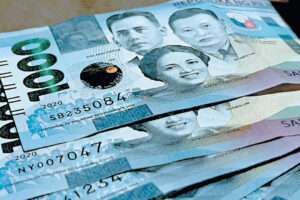




Monthly Economic Update: One for the road
 DOWNLOAD
DOWNLOAD

Inflation Update: Still low, still slow
 DOWNLOAD
DOWNLOAD

Philippines Trade Update: Exports momentum continues
 DOWNLOAD
DOWNLOAD


Gov’t gross borrowings hit PHP 508.5B in Aug.

The national government’s (NG) gross borrowings nearly tripled in August amid sharp rise in domestic and foreign borrowings, the Bureau of the Treasury (BTr) said.
The latest data from the Treasury showed that total gross borrowings jumped by 192% to PHP 508.53 billion in August from PHP 174.03 billion in the same month a year ago.
Month on month, gross borrowings surged by 206% from PHP 166.11 billion in July.
Domestic borrowings, which made up 97.97% of the total, rose by 198% to PHP 498.21 billion in August from PHP 167.05 billion in the same month last year.
This was composed of PHP 425.61 billion in retail Treasury bonds (RTB), PHP 60 billion in fixed-rate Treasury bonds (T-bonds), and PHP 12.6 billion in Treasury bills (T-bills).
External borrowings, which mainly consisted of project loans, climbed by 47.57% to PHP 10.31 billion in August from PHP 6.99 billion in the previous year.
Rizal Commercial Banking Corp. Chief Economist Michael L. Ricafort said elevated gross borrowings in August were likely driven by the latest RTB issuance as the government needed additional funds to plug the budget deficit.
The government raised PHP 507.16 billion from the issuance of RTBs in August, exceeding the PHP 30-billion target.
“The large increase in borrowings can be attributed to the large issuance of domestic debt securities by the government which successfully met the demand for these securities amid investors seeking safe returns,” Reinielle Matt M. Erece, an economist at Oikonomia Advisory and Research, Inc., said in a Viber message.
End-August borrowing
Meanwhile, NG’s gross borrowings stood at PHP 2.27 trillion in the January-to-August period, up 17.22% from PHP 1.93 trillion a year ago.
The total borrowings accounted for 87.16% of the revised PHP 2.6-trillion financing program for 2025.
Domestic debt accounted for the bulk or 81.19% of total gross borrowings in the first eight months.
Gross domestic debt increased by 11.46% to PHP 1.84 trillion as of end-August from PHP 1.65 trillion in the same period last year. This made up 87.12% of the PHP 2.11-trillion program this year.
Broken down, domestic debt was composed of PHP 941.84 billion in fixed-rate Treasury bonds, PHP 425.61 billion in RTBs, PHP 300 fixed-rate Treasury notes, and PHP 172.45 in T-bills.
As of end-August, gross external debt rose by 50.89% to PHP 426.23 billion from PHP 282.46 billion a year ago. The total foreign borrowings in the January-to-August period accounted for 87.31% of the PHP 488.17-billion program this year.
Broken down, foreign debt was made up of PHP 191.97 billion in global bonds, PHP 171.31 billion in program loans and PHP 62.96 billion in project loans.
External borrowings in the end-August period were also padded by the global bond issuance that raised USD 3.3 billion or PHP 192 billion in late January but settled in February.
Mr. Ricafort said the government would likely exceed its borrowing program with the ballooning budget deficit.
“There is a chance if the budget deficit widened for the rest of 2025 and needed to be funded by additional NG borrowings,” he said.
Separate data from the BTr showed that the fiscal gap swelled by 56.38% to PHP 84.8 billion in August, which brought the eight-month deficit to PHP 869.2 billion.
“The government’s recalibration of debt to increase the share of domestic debt over foreign debt sources is reflective in the composition of new borrowings this August. We may see the same trend in the coming months,” Mr. Erece said.
The government favors domestic sources of debt as it aims to reduce foreign currency risk.
The BTr earlier said it is looking to borrow PHP 437 billion from the domestic market in the fourth quarter, comprised of PHP 262 billion in T-bills and PHP 75 billion in T-bonds.
For 2026, the financing program is set at PHP 2.68 trillion, of which PHP 2.05 trillion will be from local lenders and PHP 627.1 billion from foreign sources.
Higher debt
Meanwhile, the share of Philippines government debt to gross domestic product (GDP) edged up to 57.8% in the second quarter of 2025 from 56.7% a year earlier, according to the Institute of International Finance quarterly debt monitor.
Household debt as a share of GDP slid to 11.3% in the second quarter this year from 12.1% in the same period a year ago.
The domestic financial sector’s debt-to-GDP ratio eased to 7.2% in the second quarter from 7.6% in the same quarter in 2024.
On the other hand, nonfinancial corporates’ debt-to-GDP ratio also eased to 25.7% in the second quarter this year from 26.8% a year ago. — A.R.A.Inosante
This article originally appeared on bworldonline.com





 By BusinessWorld
By BusinessWorld